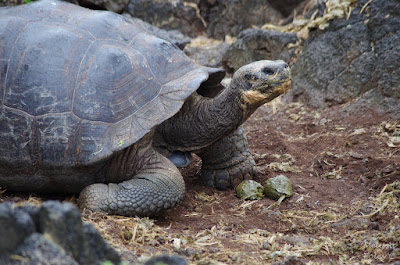Pete and I crossed a long-standing travel destination off our travel wish list at the end of 2015...the Galápagos. The Galápagos Islands, an archipelago of volcanic islands, lie 800 miles west of Ecuador and South America. Because of their geographic isolation, there are numerous species that are unique to the Galápagos. These characteristics have made the Galápagos a playground for evolutionary biologists for centuries. I have a PhD in ecology and evolutionary biology and Pete has a BS in marine biology. The unique critters in the Galápagos helped one of the most famous ecologists develop the theory of natural selection and were the cornerstone of our education. Going to the Galápagos was akin to a trip to Mecca for us. And "Mecca" did not disappoint!
One of the earliest and most prominent scientists to spend time on the Galápagos was Charles Darwin. In fact, his theory of natural selection was largely informed by the species he collected during the five weeks he spent in the Galápagos as a naturalist aboard the HMS Beagle. Darwin hypothesized that species found on the Galápagos were different from those on the South American continent because they had been isolated from those populations for a significant amount of time. By being isolated from mainland populations for generations, species slowly adapted to the conditions in the Galápagos, becoming increasingly different from populations on the mainland with each generation. So, while genes determine the traits of an individual, the variability in those genes makes some individuals better adapted to specific environmental conditions than others (conditions could include things like temperature, humidity, food type and availability, and predators). Being better adapted means higher offspring production and survival, increasing the frequency of traits in the population that are adapted to conditions at the time. For example, a lizard that blends into its surroundings better than the next lizard is more likely to not be eaten by a bird. As long as that coloration is an inherited trait, the offspring of the well-camouflaged lizard will also be less likely to get eaten...as long as the surroundings don't change between generations. And that lizard that got eaten...well, it didn't get to pass its not-well-camouflaged genes to the next generation so that coloration eventually goes away. In the science world we shorten this interaction between genes and the environment to G x E. Genes AND the environment determine the trajectory of species adaptations over time. If two places have different environments and there is little movement between the two places, eventually what was one species becomes two.
Charles Darwin is kind of a big deal here...
his work helped put this place on the map for scientists!
his work helped put this place on the map for scientists!
In the Galápagos, G x E was happening on two spatial scales: 1. between the mainland and the islands; and 2. between the individual islands of the archipelago. The most charismatic species that have become differentiated between the mainland, as well as between the islands are the lava lizards, marine iguanas, giant cactus, and the ever lovable giant tortoises.
Let's start with the lava lizards. Below are three photos of males from three different islands. Notice the difference in their coloration.
lava lizard from Española
lava lizard from Bartolomé
Next up are the marine iguanas. Their coloration (at least for the breeding males) is also really different between the islands.
The giant cactus has two growth forms...the tree variety that keeps the fleshy pads far from the ground and the normal variety with the pads close to the ground. Why the difference? That yellow guy below. Land iguanas love to snack on the cactus pads so on islands where they are present, the tree variety of the giant cactus evolved. On islands without the land iguanas, the cactus grows close to the ground. The species interactions are beautifully simple on the Galápagos, which is another reason why evolutionary ecologists love this place.
The Galápagos, which means saddle, are named for the giant tortoises that explorers found when they landed on the islands. The shell of the tortoises takes multiple forms and is different on the different islands (14 different species in total). Some have domed shells, others saddle-backed shells, and others somewhere in the middle. In general, the domed shell tortoises live on the larger islands where vegetation (food) is abundant. The saddle-backed tortoises live on more arid islands where food is more scarce and grows higher from the ground, so they need that extra tilt in their shell to extend their necks higher to reach food.
saddle-backed tortoise - look at the long reach of the neck!
The Galápagos finches are perhaps the most famous and best studied group of birds in the Galápagos, thanks to Darwin in the 1800s and Peter and Rosemary Grant over the last 40+ years. There are currently 13 species of finch that are believed to have evolved from a single ancestor that colonized the Galápagos millions of years ago. The main difference between each species is the shape and size of the beak. Each species is adapted to a particular food type (e.g., insects, seeds, fruits), which vary in abundance across the islands and under different climatic conditions. We saw mainly seed eaters, but even they have noticeably different beak shapes.
medium male ground finch with a thick beak -
good for crushing big seeds

sharp-beaked ground finch -
the sharp beak allows this guy to get seeds out of harder to reach places





















































